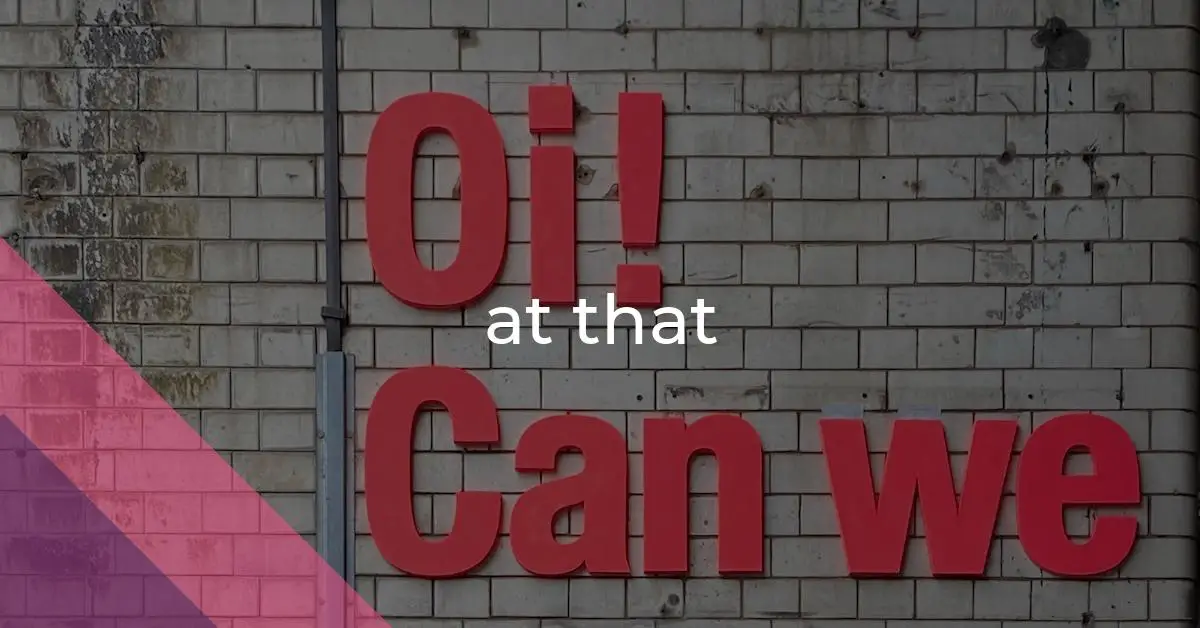at that: Idiom Meaning and Origin
What does ‘at that’ mean?
The idiom "at that" is used to refer to something that is additional, surprising, or impressive, often used to emphasize a previous statement or comment.

Idiom Explorer
The idiom "that's saying something" is used to highlight a statement that is particularly noteworthy or impressive, often because it exceeds expectations or goes against common assumptions.
The idiom "for that matter" is used to add a related or similar point to a previous statement or question, suggesting that it is equally applicable or relevant. It is often used to expand on a topic or to indicate that something is true in a more general sense.
The idiom "element of surprise" refers to the unexpected or unforeseen component or factor that creates a stunning or shocking outcome in a situation.
An idiom used to describe something ordinary, typical, or unremarkable.
The idiom "come to mention it" is used when someone suddenly remembers or brings up a particular topic or point during a conversation.
"By the way" is an idiomatic phrase used to introduce or add something to a conversation that may be unrelated or off topic but is worth mentioning. It is commonly used to provide additional information or ask a question that is not directly related to the main topic of discussion.
The idiom "but then" is used to introduce a contrasting or unexpected statement or situation after a previous statement, often indicating a change or shift in perspective or outcome.
The idiom "be that as it may" is used to acknowledge and temporarily set aside a previous statement or argument, often implying that it may not be relevant or important to the current discussion.
The idiom "believe it or not" is used to introduce something surprising or hard to believe, but true. It is often used to add emphasis to a statement or anecdote.
"And whatnot" is an idiomatic expression used to imply that there are additional unspecified things, people, or actions related to the topic being discussed.
Unraveling 'At That': Multidimensional Semantics
The idiom "at that" is a commonly used phrase in the English language. It has been around for centuries, dating back to the 17th century. This makes it quite an old idiom, with a rich history behind it. "At that" is primarily used as a coordinating conjunction, which sets it apart from other idiomatic expressions. Let's explore the different ways in which this idiom is used and how it adds depth and emphasis to statements.
One of the main functions of the idiom "at that" is to indicate an additional or unexpected element in a statement. It acts as a way to introduce a surprising or notable detail that may not have been previously mentioned. For example, consider the sentence "She is an amazing singer and an accomplished pianist at that." Here, the phrase "at that" emphasizes the unexpected revelation of the person's musical abilities. It adds an extra layer of depth and vividness to the statement, making it more interesting and engaging.
Furthermore, "at that" can also be used to express agreement or confirmation. In this context, it serves as a way to affirm or acknowledge a preceding statement. Let's take the sentence "He's a talented writer, and a published author at that" as an example. The phrase "at that" reinforces the truthfulness and validity of the initial assertion. It shows agreement and adds weight to the statement, making it more convincing.
"At that" can also be used to intensify a description or emphasize a particular quality. It adds a sense of emphasis or emphasis to the preceding statement, placing particular importance on the characteristic being highlighted. For instance, consider the sentence "He is a skilled surgeon, and a renowned one at that." Here, the phrase "at that" underscores the exceptional reputation and expertise of the individual being discussed. It highlights the outstanding quality of the person's skills, making them stand out even more.
In addition to its primary usage, the idiom "at that" also has some variations and alternative forms. One such alternative is "and all that." This alternative form serves a similar function of adding extra details or confirming previous assertions. It can be used interchangeably with "at that" in many contexts, further showcasing the versatility and flexibility of this idiom. Language enthusiasts and scholars find the variations and alternative forms of idioms like "at that" fascinating to study and analyze.
The idiom "that's saying something" is related to the idiom "at that." It is often used to emphasize the significance of a statement or achievement. For example, consider the sentence "He managed to climb Mount Everest without any prior mountaineering experience. That's saying something." Here, the phrase "that's saying something" adds further emphasis to the remarkable accomplishment of climbing Mount Everest. It highlights the magnitude of the achievement and impresses upon the reader or listener the scale of the challenge overcome.
Another related idiom is "for that matter." This idiom is used to introduce a related statement or an alternative viewpoint. It is often used to indicate that the previous statement applies to a broader context or a different situation. For example, consider the sentence "She doesn't enjoy spicy food, and for that matter, she avoids anything with even a hint of heat." Here, the phrase "for that matter" connects the dislike of spicy food to a broader avoidance of anything with heat. It expands the scope of the statement and provides additional context.
The idiom "at that" is a versatile phrase that is commonly used in English. Its ability to introduce surprising details, confirm statements, and emphasize qualities makes it a valuable linguistic tool. The idiom has a long history and has been used for centuries, demonstrating its enduring relevance in contemporary language. The variations and alternative forms of this idiom add even more depth and possibilities. The related idioms "that's saying something" and "for that matter" further enhance the idiom "at that," providing alternative ways to express emphasis and introduce related statements. Language enthusiasts and scholars find these idioms intriguing to study and analyze, as they offer unique insights into the English language and its usage.
Example usage
Examples of how the idiom "at that" can be used in a sentence:
- She did well in her interview and received a job offer at that.
- The weather was already getting colder, and at that, it started to snow.
- He was a great athlete, an amazing pianist, and a brilliant student at that.
The idiom "at that" is commonly used to add emphasis or provide additional information to a statement. It can be used to indicate an unexpected outcome or a new development, as seen in the first two examples. In the first example, the person not only did well in the interview but also received a job offer, highlighting the unexpected positive result. Similarly, the second example highlights the sudden change in weather from getting colder to snowing.
The idiom can also be used to add emphasis or emphasize someone's qualities or abilities. In the third example, the person is described as not only a great athlete but also an amazing pianist and a brilliant student, emphasizing their multiple talents.
More "conjunction" idioms



